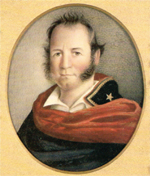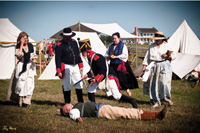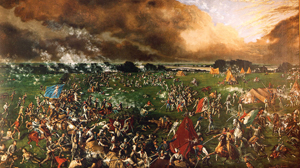COVER STORY By Joan Frances | Photo courtesy of the Fort Bend County Museum Association. –
Fort Bend County history is interesting, engaging and authentic. Our local history is entwined with the historic events of our great state, including perhaps the most important date in Texas history: March 2nd.

Ready, aim, fire! In this reenactment at the George Ranch Historical Park, the Texians banded together to protect their homesteads from the advancing Mexican army.
On March 2, 1836, Texas won freedom from Mexico and became a sovereign nation called the Republic of Texas. Texas Independence Day celebrates the adoption of the Texas Declaration of Independence each year on March 2nd, and in Fort Bend, there is an organization devoted to preserving and celebrating our Texas heritage.
The Fort Bend County Museum Association in Richmond is devoted to the community guaranteeing all historical records are accurate, available to the public and well-documented. The organization operates a local history museum and six historic structures in Richmond, an avocational archeological society, a downtown historic district and programs at the 480-acre George Ranch Historical Park.

This watercolor on ivory of Sam Houston was painted in the 1840s and is attributed to George Catlin.
Chris Godbold, Chief Curator of the Museum, is a walking book of knowledge when the subject of Texas Independence is addressed. “Fort Bend County was part of the foundations of Texas independence because some of the first of Austin’s colonists settled here. They were United States citizens looking for a new start, who didn’t really want the Spanish or later the Mexican government to tightly control their affairs. More specifically, what would become Fort Bend County sent several men to the Texas Army, among them John and Paschal Borden, George W. Pleasants and Wyly Martin. Local men, such as Eli Fenn, served to guard the ferry landings on the Brazos.” These brave men helped make not only Texas – but Fort Bend County – what it is today.
 The Texas Revolution is perhaps one the most thrilling stories of unprecedented victory for Texas liberty. Strategic, methodical and risky, the battle at San Jacinto was the turning point for Texians. Sam Houston, Commander-in-Chief of the Texas Army, and his troop of 910 pioneers fought the battle that lasted less than 20 minutes against Antonio Lopez de Santa Anna, president and dictator of Mexico. Six years before this historical conquest, the Mexican government declared an edict on April 6, 1830 prohibiting further immigration of Anglo Americans from the United States to Texas. After the tragic defeat in March of 1836 in San Antonio when the Alamo had fallen and its 183 brave defenders were massacred, an exodus of frantic colonists known as the “Runaway Scrape” transpired. Packing what belongings they could take in wagons and carts, on horseback or on their own backs, these people fled their homes in terror across the rain soaked country all moving eastward to Fort Bend, then to Louisiana to escape the wrath of the bloodthirsty Santa Anna.
The Texas Revolution is perhaps one the most thrilling stories of unprecedented victory for Texas liberty. Strategic, methodical and risky, the battle at San Jacinto was the turning point for Texians. Sam Houston, Commander-in-Chief of the Texas Army, and his troop of 910 pioneers fought the battle that lasted less than 20 minutes against Antonio Lopez de Santa Anna, president and dictator of Mexico. Six years before this historical conquest, the Mexican government declared an edict on April 6, 1830 prohibiting further immigration of Anglo Americans from the United States to Texas. After the tragic defeat in March of 1836 in San Antonio when the Alamo had fallen and its 183 brave defenders were massacred, an exodus of frantic colonists known as the “Runaway Scrape” transpired. Packing what belongings they could take in wagons and carts, on horseback or on their own backs, these people fled their homes in terror across the rain soaked country all moving eastward to Fort Bend, then to Louisiana to escape the wrath of the bloodthirsty Santa Anna.

Soldados checked for valuables on a Texian casualty following a skirmish during the war for Texas independence.
A log fort built at the bend in the Brazos River became the nucleus of the settlement, which came to be known as Fort Bend or “Fort Settlement.” The Brazos River and other local tributaries played an integral role in the outcome of the war. Santa Anna’s main army marched south along the Brazos, resting three days at the Hunter Plantation, just north of Fort Settlement. Sam Houston used the steamboat Yellowstone to ferry his army across the swollen Brazos, then traveled to the open fields of San Jacinto. When Santa Anna traveled 60 miles south to San Jacinto, they were seen crossing Vince’s Bridge over Vince’s Bayou. John Coker, a private in Sam Houston’s calvary, suggested to General Houston that the destruction of the bridge would distract the Mexican Army. Erastus “Deaf” Smith, the chief scout against the Mexicans, was selected to take a few cavalrymen, evade the enemy and to cross and destroy the bridge. The burning of Vince’s Bridge assured no chance of retreat for the Mexican Army. On April 21st, Sam Houston’s army of only 800 men killed and captured the Mexican troops of 1,200 men by surprise at San Jacinto. Santa Anna, attempting to escape, soon came to the burning bridge and was captured. The news of this defeat and victory guaranteed independence from Mexican control and enabled Texas to become an independent republic.

Henry Arthur McArdle’s 1895 painting Battle of San Jacinto depicts a detailed panorama of the battle.
Life in Fort Bend County likely did not change much after Texas gained its independence. “Texians were already used to governing themselves and managing their own affairs,” said Godbold. “A fledgling Texas government was already formed by the rebelling Texians. Some changes were made as the Republic of Texas was formed, but many things continued just as they had since the first colonists arrived along the Brazos. Celebrations of their hard fought independence ensued, but many Fort Bend residents were soon preoccupied with rebuilding their homes, farms and ranches after returning from the Runaway Scrape. Work on the farm or ranch was the same. It didn’t matter whether the flag that flew over it was Mexican or Texan.”
Texas independence did bring with it development of Fort Bend County with promoters competing to form the next boom town. Robert Eden Handy and William Lusk began advertising their city of Richmond in 1837. It was incorporated by the Congress of the Republic in May of that year on the same act that incorporated Houston and Nacogdoches. To this point, Fort Bend had been split between Austin and Harrisburg County with the border being the Brazos River. However, enough people had settled in the area that the Congress Republic created Fort Bend County in December of 1837. After a year and a half of independence, the people of Fort Bend had their own county with a new city, Richmond, as its county seat.
The men who fought in the Texas Revolution will never be forgotten thanks to the efforts of Chris Godbold and the devoted benefactors of the Fort Bend County Museum Association. Throughout the year, lecture series are scheduled to inform the public of historical events that shaped our government, as well as special events celebrating our heritage. For a complete listing of events and activities, visit fortbendmuseum.org.